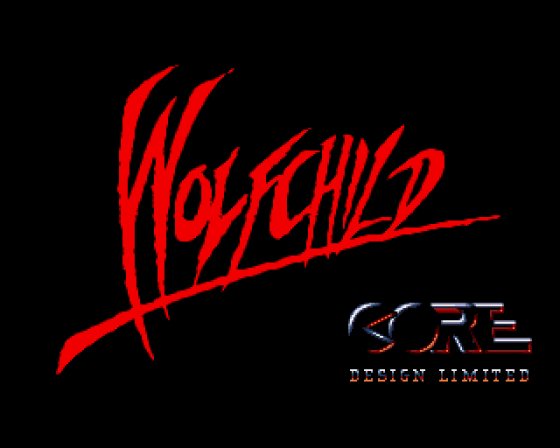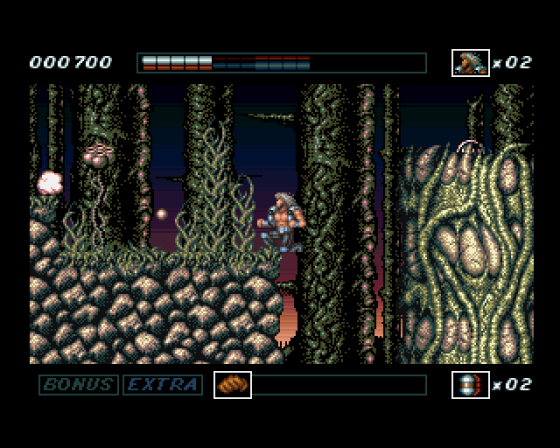
Amiga Power
 1st February 1992
1st February 1992
Categories: Review: Software
Author: Stuart Campbell
Publisher: Core
Machine: Amiga 500
Published in Amiga Power #10
Wolfchild
We've had Switchblade, and Switchblade II. Now comes, erm, another Switchblade II. Except it isn't really. Confused? Well...
There have been a lot of pretty great wolves through history, lycanthrope fans: White Fang, The Big Bad, Lon Chaney Jnr., Citizen 'Wolfie' Smith, Michael J. Fox's Teen Wolf (okay, so we're stretching the defintion of 'great' just a bit here), the American Werewolf in London, um, Johnny Alpha's mate Wulf Sternhammer, er - oh, year, proto-feminist author Virginia Woolf, and, uh, top dead German dude Wolfgang Amadeus Mozart, of course. [You're fired! - Ed]
But there haven't, as far as I can remember, been any great baby wolves. Luckily, Wolfchild hasn't got anything whatsoever to do with baby wolves, so that's not important. Nope, Core's Wolfchild is actually an unfortunate character called Saul, whose father has been kidnapped and the rest of his family slaughtered by the evil Draxx. Conveniently though, Saul is afflicted with the power to turn into a spooky man-wolf character armed with psychic weapons, and thus armed he sets off through five levels of all the usual old platforms and slimy beasties to kill Draxx and free his dad. What psychological traumas await the pair of them as they try to re-adjust to home life without the rest of the family are, perhaps wisely, left to the sequel.
In With A Silver Bullet

Wolfchild comes to you from the drawing board of Simon Phipps, the man behind the original Switchblade. You can tell, too, because Wolfchild is so similar to that earlier game in a number of ways that it's probably almost fair to call this the "true" Switchblade II (Simon had nothing to do with the sequel published earlier this year by Gremlin, and is on record for not caring for it much). The basic game structure is almost identical to Switchblade I (lots of platform-leaping, hidden rooms hiding behind destructible walls, power-ups and bonuses concealed inside destructible containers littering the playing area, limited-use power-up weapons), many of the enemies look like characters from the original game beefed up a bit, even the 'Bonus' and 'Extra' letter-collecting for bonus points and extra lives is the same. There's no escaping it, if you played Switchblade you'll feel awfully at home here.
Unfortunately, Wolfchild also shares many of Switchblade's deficiencies, expands on some of them and then adds a few of its own. The biggest irritation is the Rick Dangerous-style invisible danger. [Oh no, here we go again - Everybody in the whole world]. While this did pop up occasionally in Switchblade, it's much more heavily used here, at least in the later levels. I'm fed up of droning on and on about why it's such a bad thing, but let's just say that this kind of pure laziness can really take the fun out of a game, not by making it harder - because it doesn't, all you have to do to avoid it is go very very slowly, inching along a pixel at a time so that you never run headlong into anything before you can react to it - but by wrecking the pace and making the game a real chore to trek through rather than a joy.
Similarly, the way that some enemies can take upwards of a dozen hits before they die is a ridiculous notion in a platform arcade game - if people want Final Fight they'll go out and buy Final Fight, or any of a dozen other real beat-'em-ups, rather than look for their fighting thrills in a platform game.

In a platform game, the trick is to work out how your enemy moves, discover his weak spot, then get in there and hit it without getting hit yourself. Having to hit it over and over again (some of the level three baddies, for example, are actually more persistent than the end-of-level guardians from levels one and two), is a complete pain in the backside, and indefensible from a design point of view. All it does is slow you up and get you heartily sick of seeing the same old scenery, especially since, when you die, you almost always get sent right back to the start of the level.
Then again, it only look me 10 minutes of play to reach the third of the game's five levels, so maybe slowing down the pace is a deliberate ploy by the programmers to distract attention from the slightly ropey nature of the parallax scrolling when things get moving at any kind of serious rate. Then again, the preposterous-looking animation of your physically-freakish hero (Arnold Schwarzenegger's body on top of Bonnie Langford's legs!) as he runs, does a pretty good job of that by itself. (Mind you, you probably won't notice any of these things, as you'll more than likely have been driven into some kind of dribbling stupor by the completely awful background music. Oh God, that background music. Please, Matt, can we have Harry Connick Jnr on again? Anything's better than this...)
Ooh, You Bitch
Alright, alright, so Wolfchild isn't so bad that it really justifies putting the boot in like that (I mean, Harry Connick Jnr... come on, nothing's that hideous). It does boast some atmospheric graphics (level three is particularly nice, in a horribly creepy, claustrophobic kind of way, and level two is pleasingly reminiscent of the Forest Of Arborea in the Flash Gordon movie), and the gameplay is harmless enough in a generic kind of way.

But really, look beneath the superficially interesting surface and what you've got here is a lifeless, undemanding and uninspiring run-of-the-mill hack-'em-up that's much more in the Frenetic/Warzone division of Core's catalogue than the Chuck Rock/Thunderhawk/Heimdall camp. After about 45 minutes of it, I found myself wandering around the office offering to review Graeme Souness's Vector Soccer, or make the tea, or clean the windows, or just anything else at all, really. When a game exerts such a loose grip on a player that Graeme Souness seems like an attractive proposition by comparison, it really is time to start worrying.
The Bottom Lion
Uppers: It looks good when it isn't moving around too much, and the gameplay's in a tried-and-trusted style which anyone can get some enjoyment out of. The wolf-transformation sound is great.
Downers: Very derivative of Switchblade, movement of both characters and scrolling is a bit on the crude side, it's too easy, there's lots of annoying invisible danger, but most importantly it just lacks any kind of spark. You've seen everything here done better elsewhere.
Initally quite good fun, but I was completely bored with it (and more than halfway through it) in less than an hour. Switchblade meets Strider, but they don't get along too well and Wolfchild is the rather half-hearted end result.

















